EHR Integrated Health System and its Importance
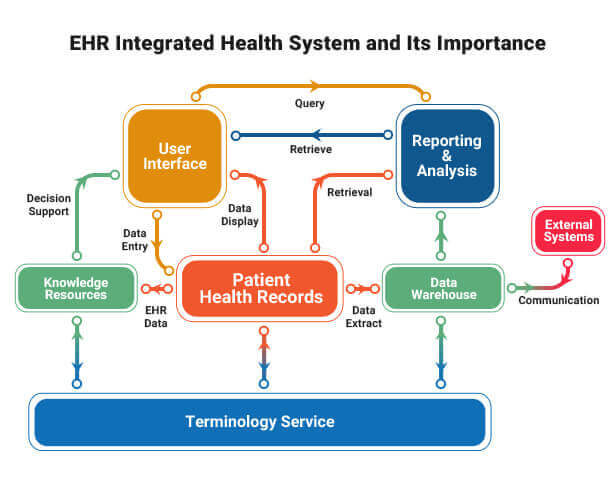
Electronic health records (EHRs) present patients’ structured data repository digitally. You must be wondering what is an integrated health system? A simple definition of integrated healthcare would be the management of comprehensive care services to address various health concerns of patients and deliver it in a user-friendly and secure manner. An EHR integrated healthcare is a key component for the success of healthcare provider solutions and vendors. Integrated health care strategy consists of collaboration and communication among health professionals. The integration process characterized by the sharing of information among team members related to patient care. Health system integration allows the establishment of a comprehensive treatment plan. Integrated healthcare management plans deal with the patient’s biological, psychological, and social needs. EDI solutions solve the challenge of interoperability and secure data transfer by building a network of integrated health systems. System integration collaborates data from digital integrated healthcare services. EHR integration process involves electronic data interchange between different healthcare professionals. System integration converts the EHR into an accessible source of integrated health information systems. Integrated care systems create dynamic clinical integration and effective communication. System integration works best for patients having complex behavioral health needs. Many complex conditions can be handled through online practice management at a lower cost using integrated models. Integrated healthcare strategies improve medical records management and reduce costs by automated healthcare solutions.
Horizontal and Vertical Integrated Systems
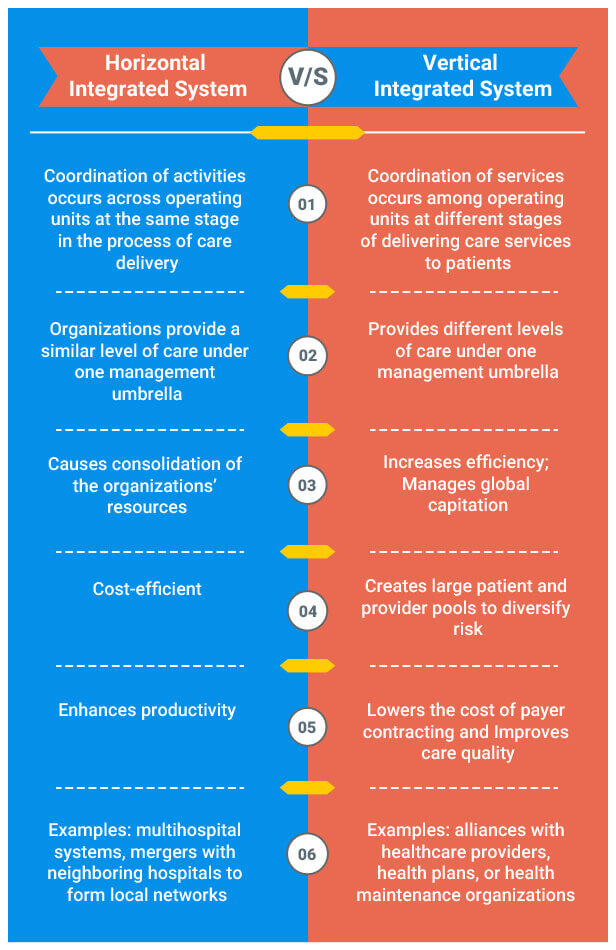
Healthcare organizations are in high demand for systems to systems integration involving different mechanisms. A suitable integrated healthcare model can be included in a hospital system integration. It would serve the purpose of employing essential health strategies. The health integration strategy needs to be carefully chosen, depending upon the organizational needs and goals. Integrated healthcare strategies can be classified into the vertical and horizontal integrated healthcare system. Integrated systems examples include mergers of social and healthcare organizations or coordination between services of units at different stages of integrated care solutions. The former is an example of horizontal integration in healthcare and the latter of a vertical integration system.
Horizontal integration in healthcare occurs when individual physicians join group practices or collaborate with existing groups. Together they provide the same products or services in integrated health systems. This approach offers increased business and the ability to venture market possibilities, which is a good healthcare strategy. It is one of the healthcare strategies that does not require high costs investments in integrated health systems. Medical services can reach many people and cover many areas through horizontal integration healthcare strategy. Horizontally integrated systems offer benefits, including improved coordination and quality of patient care, in-house referrals, and high-revenue services.
Vertical integration in healthcare means a single firm of two or more production stages that provides separate services. Healthcare companies operating in various points of a given supply chain can adopt a vertical integration strategy. This type of integrated healthcare systems eliminate the middleman and offer various services and products. The trend of vertical integration in healthcare has been high over recent years. Hospital systems, drug manufacturers, wholesale distributors, pharmacy benefit managers (PBMs), retail pharmacy outlets, and medical insurers promote vertically integrated healthcare solutions. Such systems integration provides a wide range of patient care and health services, thus producing more efficiency and lower cost.
Benefits of an Integrated Healthcare System
Integrated healthcare strategies offer many advantages.
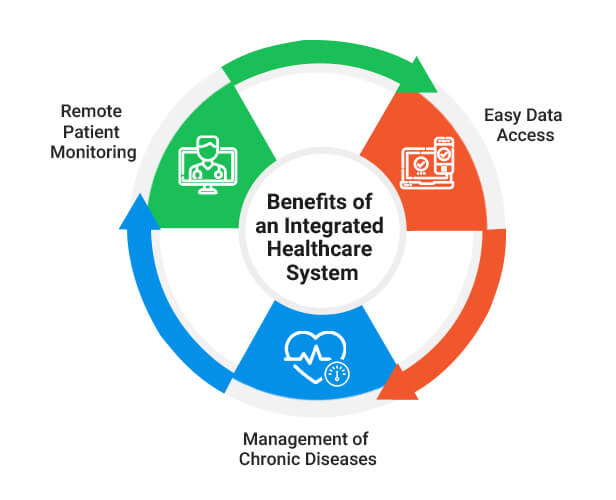
Easy data access: Integration systems allow information integrated from various healthcare providers to be readily available on online cloud platforms due to healthcare IT integration. Doctors can communicate through the HL7 interface and share vital information. Patients can learn about their reports and track the status of their health through healthcare IT integration. An integration engine helps to modernize the integrated models of healthcare delivery. Integrated health strategies contain combined data from clinical informatics, electronic labs, genomics, radiology, imaging, and so on.
Management of chronic diseases: Integrated healthcare strategies promote sharing of free-flowing data using an integrated information system. This creates new possibilities for healthcare providers to offer better patient care services using integration systems. An integration engine assists data exchange and creates transparency across health care networks. Electronically exchanged data can be used for understanding the extent of health risk behaviors. An integration system would help you adopt preventive integrated care practices. Integrated healthcare assists in chronic diseases, helps to identify research gaps, monitors population trends and evaluates programs. This strategy serves useful in successful population health management.
Remote patient monitoring: Integrated healthcare strategies provide a range of new technologies such as an integrated healthcare information system. An integration system enables the promotion of remote patient monitoring from any location. Online applications like mhealth and telehealth serve useful. Online monitoring helps patients to access care services from healthcare providers across any location. It eliminates waiting times for patients and a reminder for appointment scheduling.
What are the Healthcare Integration Strategies?
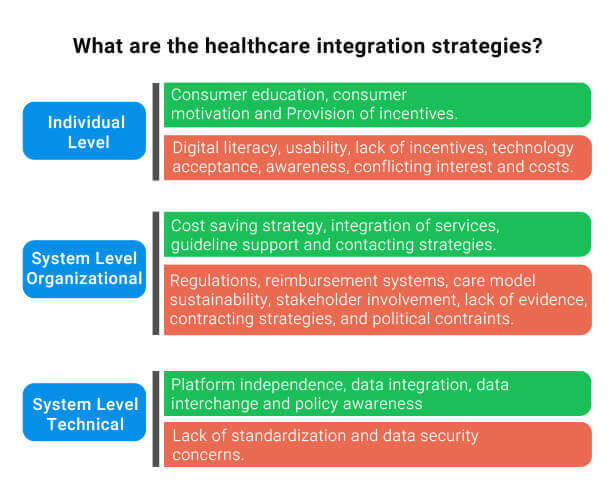
Implementing healthcare systems integration comes with potential challenges such as healthcare interoperability or HL7 integration issues. Therefore, it is important to be aware of healthcare integration strategies. Let’s see what you need to do to have a successful EHR integrated healthcare system.
Overcome Data problems: The data received in integrated healthcare may not be the same because of the different sources involved. It is essential to identify your data needs and eliminate unnecessary data and data silos. Similarly, a lack of critical data may also cost you. So how do you deal with this data dilemma? Establish HIPAA compliant data standards during electronic data exchange with vendors and other healthcare professionals. Discuss with them and decide a particular format to be used to avoid data silos. It would help if you also determined the value of the various data types applicable. Identify what type of data is required in which situation. Your healthcare systems strategy should consider factors like diagnosis schedule, physician and staff time, and the patient’s condition during procedures if any. These factors will vary with a different medical case and then your data should account for relevant information. The bottom line is, you must understand the data use patterns through your integrated healthcare strategies. Once the data needs are recognized, only the essential data can be supplied, thereby enhancing productivity.
Cater to healthcare Data integration and migration: In integrated healthcare, organizations of various capacities tend to upgrade their EHR systems to meet the growing clinical demand. To adapt to this dynamic environment, you require a flexible, ongoing strategy suitable for EHR migration and data integration in healthcare. Electronic data migrations and HL7 interfaces stimulate the exchange of electronic data between EHR platforms. However, there may be data gaps in evolving technologies that you need to watch out for.
Focus on patient care:
Develop a patient-centered approach that addresses the patient’s needs. It should also encourage patient engagement systems and participation. A population management approach will enable the evaluation of population-based health needs.
Standardize your integrated care delivery system: One of the key aspects of integrated healthcare strategies is to incorporate interprofessional teams across the collaborative care continuum. If all the teams involved design evidence-based care guidelines and protocols, a standard of care services can be established.
Performance management: Educate your staff about the importance of introducing integrated healthcare strategies. Ensure that they are dedicated to integrated health care management and open to improving the integrated healthcare delivery system. You must remember that patient diagnosis, treatment, and care interventions are linked to clinical outcomes.
Up-to-date information system: Ensure that your information systems and HL7 interface align with the latest technology. Information systems must allow you to collect, track, and report activities. If your information systems are maintained efficiently, communication, and data flow across the care continuum will improve greatly.
Sort out your finances:
Plan your finances before applying integrated healthcare strategies. Ensure that your service funding is in place for the distribution of different care services. Funding needs to promote interprofessional teamwork and healthcare services. You need to arrange sufficient funding to gather adequate resources for implementing the integrated healthcare strategies you select.
Trends in Healthcare Strategies
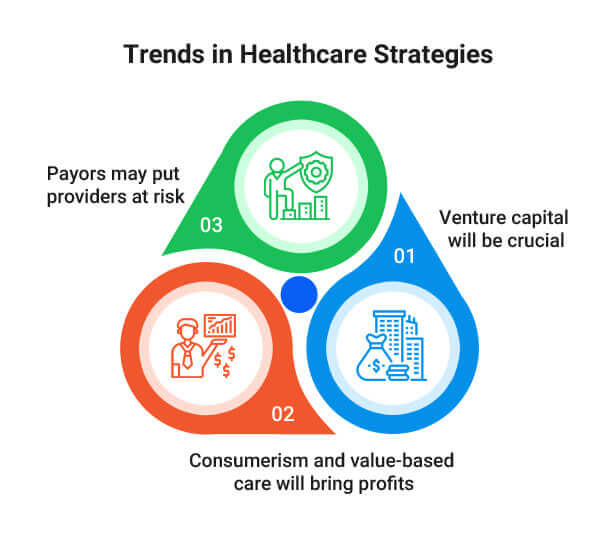
The healthcare industry is always transforming, and 2023 will be no exception. New technologies such as artificial intelligence to gene therapy are expected to create changes. Healthcare integration trends will also come that will change the shape of the healthcare sector. Here’s a list of integrated healthcare strategies that will be on the top in 2023:
Consumerism and value-based care will bring profits
Patients like the ease of access, user-friendliness, good experience, and high-quality care. If the patients feel they get good value for their payment, they are satisfied. Improved care services with trained staff and advanced technology will increase patient engagement. A successful integrated healthcare strategy treats patients as customers who get value for the care provided. Integrated healthcare keeps patients informed about all the integration processes, and there is clear communication. This consumer-driven behavior will be one of the topmost integrated healthcare strategies to assure success. Healthcare professionals need to understand the importance of consumer needs and lead accordingly.
Venture capital will be crucial
Private equity and capital will continue to play an essential part in 2023. These investors’ main focus will be disruptive care models allowing delivery of services outside traditional hospital care settings. Both investors and investor-funded integrated health solutions can benefit from collaboration or integration process with local health care infrastructure. In addition to finance, outside investors will bring experience and strategic insights. These inputs will assist the payors and providers to be more successful.
Payors may put providers at risk
This is one of the consistent trends in integrated healthcare strategies over recent decades. The risk from government payors can be transferred to health care providers. Employers increasingly perceive risk-based contracting as a means to reduce costs. In this way, they lose interest in subsidizing Medicare and Medicaid through higher premiums. In events of an economic downturn before 2023, providers may receive employer pressure on premium costs to increase rapidly.
Conclusion
Now you know what trends to expect in integrated healthcare strategies for 2023. We can help you stay ahead of the game in 2023 by assisting with the implementation of the key steps required. Health systems integration needs to establish their goals and develop a strategic plan based on current healthcare landscape knowledge. Remember to design strategies that would give patients the value of customers. Building capacity for integrating claims and clinical data is also essential.
References:
https://hitconsultant.net/2016/03/14/why-ehr-integration-crucial-digital-health-innovation/#.X7aXdWgzY2w
https://www.vocera.com/product/integration-electronic-health-record-systems
https://blueehr.com/behavioral-health-integrated-care/
https://www.pharmacytimes.com/news/vertical-integration-in-health-care-the-next-stairway-to-heaven
https://www.apa.org/health/integrated-health-care
https://www.usa.philips.com/healthcare/nobounds/phoenix-childrens-benefits-integrated-health-it
https://www.orchestratehealthcare.com/healthcare-system-integration-strategies-changing/
https://www.ncbi.nlm.nih.gov/pmc/articles/PMC3004930/
https://pubmed.ncbi.nlm.nih.gov/24749215/
https://www.foxgrp.com/healthcare-feasibility-studies/strategic-trends-in-healthcare-2020/
https://copehealthsolutions.com/cblog/2020-healthcare-forecast-4-key-trends-and-10-essential-strategies/
https://www.healthcatalyst.com/insights/2020-healthcare-trends-and-how-to-prepare
OSP is a trusted software development company that delivers bespoke solutions as per your business needs. Connect with us to hire the best talents in the industry to build enterprise-grade software.

How can we help?
Fill out the short form below or call us at (888) 846-5382
Looking for software solutions to build your product?
Let's discuss your software solutions for your product in our free development acceleration call!
Get In Touch arrow_forwardDiscuss Your Project Handover with a team of expert Book a free consultation arrow_forward
About Author

Written by Riken Shah linkedin
Riken's work motto is to help healthcare providers use technological advancements to make healthcare easily accessible to all stakeholders, from providers to patients. Under his leadership and guidance, OSP Labs has successfully developed over 600 customized software solutions for 200+ healthcare clients across continents.

















